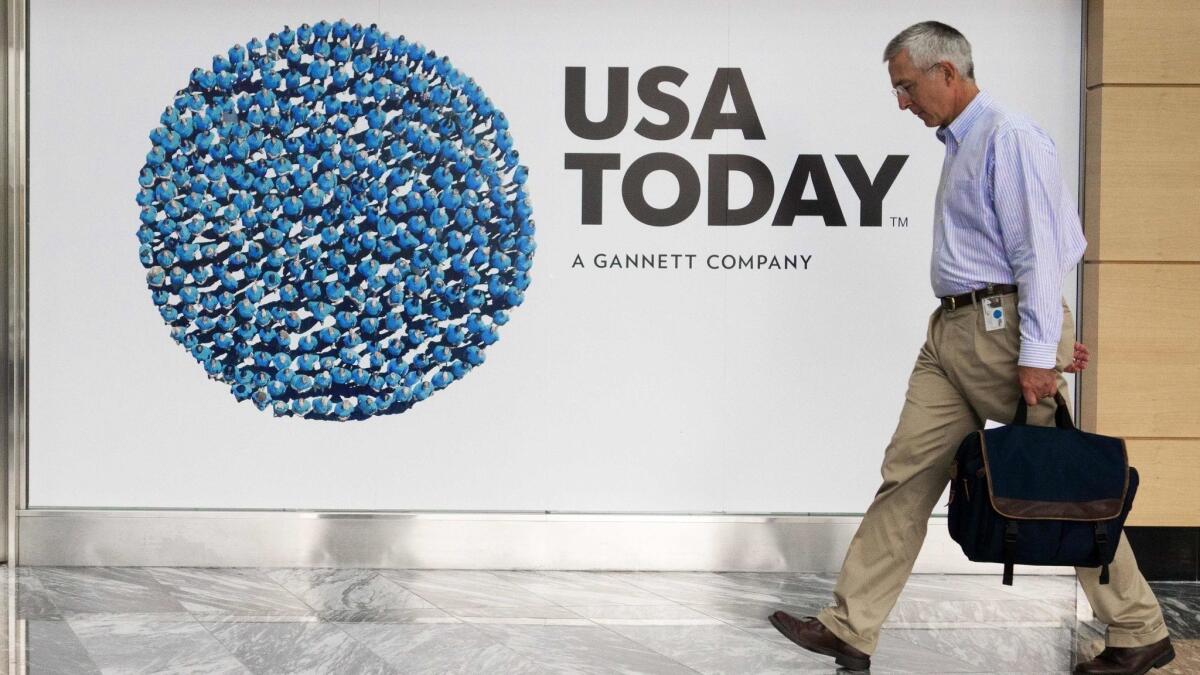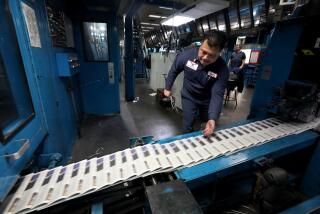Column: A vulture firmâs bid for Gannett shows thereâs still value in newspapers â for plundering

Among those who believe that the press provides value for society â especially local journalism that slaps state and municipal politiciansâ hands out of the public cookie jar â Alden Global Capital is a âvulture investingâ firm that makes real vultures look good by comparison.
The private equity firm and its subsidiary Media News Group, or MNG, have become renowned for buying up local newspapers and sucking them dry through layoffs and other ruthless cost-cutting. Media News has applied this strategy to a portfolio that now includes about 200 publications.
Now Alden appears to be angling to turn another limping wildebeest on the American media veld into a carcass. On Monday, Media News Group announced a $1.4-billion hostile bid for Gannett Co. With 100 publications, including USA Today, Gannett is one of the nationâs largest newspaper chains. But it has been struggling financially, and its chief executive, Bob Dickey, has announced he plans to retire in May.
Their focus is on a race to the bottom, collecting all the money they can on the way down.
— News industry analyst Ken Doctor, referring to Alden Global Capital
As newspaper industry observer Ken Doctor put it this week, âa lame-duck CEO preparing to announce another quarter of troubleâ made Gannett eminently vulnerable to a takeover bid, and MNG struck.
The bid underscores the dilemma facing the newspaper industry, especially at the community level. The old business model, based on print advertising by a combination of local and national advertisers, is on its way out; advertisers have too many other platforms to reach customers, and the vast majority of remaining newspaper readers are in the aging demographic that most advertisers donât care for.
Savvier leaders in the news business know they have to make the transition to digital delivery, which is how readers increasingly receive their news. That means changing to a subscription model in which the readers pay directly for content.
That requires more investment, not less. Gannett has been trying to move in that direction, as have other locally oriented chains such as Sacramento-based McClatchy. But thatâs not Aldenâs playbook.
âTheir focus is on a race to the bottom, collecting all the money they can on the way down,â Doctor told me. Alden is not alone. âItâs more brutal about cutting and not trying at all to find a digital future,â he says, but he forecasts that 65% to 85% of local newspapers eventually will âfall into the hands of those harvesting profits and not investing.â
The firmâs bid for Gannett promises more of the same. According to its announcement, upon taking over the company, Alden would âimmediately ⌠commit to a moratorium on digital acquisitions.â Although the firm expressed in a letter to the Gannett board its âdesire to grow in the newspaper business over the long term,â it also described itself as an industry âconsolidatorâ and boasted of its track record of âacquiring newspaper businesses and running them in a profitable and sustainable way.â Gannett said only that it would âcarefully review the proposalâ from Alden.
Alden is hardly the only newspaper owner focused on plunder. In December 2017, Tribune Publishing, then the owner of The Times, announced an extraordinary payout for Michael Ferro, its largest shareholder. Ferroâs Merrick Ventures was to receive an annual fee of $5 million in cash, payable on the first business day of January each year. The initial term of the deal was three years. In 2017, the company earned a profit of only $5.5 million. (Ferro earlier had headed off a merger bid for Tribune Publishing, then known as Tronc, from Gannett.)
Newspapers have been shedding jobs consistently, but Alden has been cutting staff at about twice the rate of the industry as a whole. The company has cut employment at its Boston Herald to about 100 from 240 at the end of 2017. The San Jose Mercury News, which had a newsroom staff of 440 during the 1990s dot-com boom, was down to about 40 a year ago.
Alden also has been harvesting enviable profits.
According to confidential financial reports that leaked into public hands, partially as a result of a lawsuit filed by one of Aldenâs investors, Aldenâs Digital First Media arm recorded an operating profit of 17% in 2017, well above most of its newspaper competitors. Digital First is the publisher of 38 California newspapers, including the Mercury News, the Orange County Register and the Los Angeles Daily News, as well as the Denver Post, the St. Paul Pioneer Press and many others. From its standpoint, the strategy is working great.
The investor lawsuit, filed in Delaware Chancery Court last March by hedge fund group Solus, asserts that Alden has squandered much of its bounty from the newspapers on questionable or unprofitable investments. These include a $158-million investment in the Fredâs grocery store chain at $17.06 per share. The stock is currently trading at about $2.80. Aldenâs Media News Group, the parent of Digital First, invested an additional $10 million in an Alden-managed fund that invests in mortgaged-backed securities and commercial real estate.
This diversion of resources from the newspapers to unrelated investments inspired an outbreak of resistance from Alden newsrooms across the country, including protest demonstrations and the publication of editorials critical of Alden in its Denver Post, where Alden has cut the newsroom staff by about 70%, reducing it to about 70 employees.
None of that has had a discernible effect on Alden. âYou canât protest against a hedge fund,â Doctor says. âTheyâre impervious.â Indeed, Aldenâs own website is utterly opaque â it bears only the firmâs name and a full-screen photo of a redwood forest, with no place to click for further information. The firm didnât respond to a request for comment left at its New York headquarters.
The signs are that Alden is counting on the last remaining newspaper readers in its circulation areas sticking with their papers out of habit of inertia, even as staff cuts drain away the quality of their journalism. Average circulation among Alden newspapers has been shrinking at about 10% a year, Doctor says, which is more than the average print decline industrywide, but not by much.
âItâs a cynical approach,â says Doctor. âThey know how much theyâll lose in circulation, and that the diminution in editorial quality will have only so much impact on subscribers.â
But readership wonât grow, either. The news industry needs a business model that looks to the future. The necessary investments wonât be modest, and the returns wonât be quick. But the Alden model points to a smaller readership, more uninformed and misinformed voters, and more political corruption. If youâre a vulture capitalist, maybe your spreadsheets make that future look pretty bright. But it doesnât work for the rest of us.
Keep up to date with Michael Hiltzik. Follow @hiltzikm on Twitter, see his Facebook page, or email [email protected].
Return to Michael Hiltzikâs blog.
More to Read
The biggest entertainment stories
Get our big stories about Hollywood, film, television, music, arts, culture and more right in your inbox as soon as they publish.
You may occasionally receive promotional content from the Los Angeles Times.











